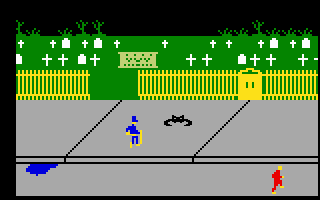Retro Replay Review
Gameplay
Dracula delivers a tense, nocturnal sandbox where players embody the legendary vampire in his prime. As the sun dips below the horizon, you’re free to roam a darkly atmospheric townscape, hunting unsuspecting victims. Each human target presents a small puzzle: do you wait patiently as they wander the streets, or attempt a riskier lure from the shadows? The thrill of the chase is amplified by the constable’s ever-watchful patrols, which dynamically respond to your attacks and force you to adapt on the fly.
The game’s core mechanics center on a fluid transformation system. After a successful feed, you can briefly call forth a horde of zombies to sow chaos among law enforcement, buy yourself precious seconds, or slip into bat form for a high-speed getaway. Both options feel satisfying: zombies charge into frays with hulking strength, while the bat offers swift aerial traversal, letting you weave between rooftops and evade stakes with nimble maneuvers. Strategic use of both forms is essential to maximize your nightly blood quota.
Environmental hazards add additional layers of challenge. Wild wolves roam the forests surrounding town, delivering savage bites if you linger too long on foot. Hawks patrol the skies, diving to snag any bats foolish enough to fly in open spaces. These natural adversaries, combined with the growing intensity of human defenders, create a dynamic risk-versus-reward system that keeps you constantly weighing your next move.
Graphics
Visually, Dracula thrives on mood and atmosphere. The game’s palette is dominated by deep purples, inky blacks, and flickering torchlight, evoking a gothic horror painting come to life. Textures on cobblestone streets and aged timber beams are richly detailed, while the characters’ animations capture the fluidity of a creature that moves between monstrous strength and eerie grace.
Lighting effects deserve special praise. Streets glimmer with lanterns that cast long, shuddering shadows—perfect for slipping unseen from behind a victim’s back. When you enter bat form, ambient fog and moonlight interplay to create hauntingly beautiful scenes as you weave between rooftops and spires. Subtle particle effects—blood splatters, embers from torches, flocks of startled birds—serve as the finishing touch to an otherwise meticulously crafted world.
While the game stops short of ultra-realism, its stylized approach complements the supernatural premise. Character models are slightly exaggerated, emphasizing Dracula’s sinewy physique and the constable’s panicked expressions. Even minor NPCs exhibit personality: a drunken villager staggers unpredictably, while a nervous shopkeeper bolts indoors if they spot you lurking. These details enrich immersion without distracting from core gameplay.
Story
Dracula’s narrative is elegantly minimalistic, unfolding primarily through environmental storytelling and brief interludes between nights. A handful of cryptic journal entries hint at the vampire’s ancient past and his simmering rivalry with local authorities. Though not a dialogue-heavy epic, these snippets add depth to your nightly objectives, framing each feeding run as part of a larger, menacing legend.
The pacing of revelations complements the gameplay loop. After every successful return to your tomb, a new clue or whispered rumor emerges: a suspicious hunter arrives in town, or the constable enlists the help of a witch doctor. These developments don’t overwhelm you with exposition but nonetheless provide motivation to push deeper into more dangerous districts seeking additional victims and arcane artifacts.
Atmosphere is the true protagonist of the story. The game excels at building a sense of dread through environmental cues: distant church bells, children’s lullabies drifting from open windows, and the constant reminder of dawn’s approach. Whether you’re stalking a lonely wanderer along misty riverbanks or battling ravenous wolves under a blood-red moon, each moment feels like a page from a dark fairy tale.
Overall Experience
Playing Dracula is a masterclass in tension and thematic cohesion. The loop of hunting, evading authorities, and racing against the clock creates an addictive night-by-night progression. Every victory leaves you hungry for more, compelling you to explore new strategies—do you fully embrace your undead army or focus on stealthy precision strikes?
The balance of challenge and reward is impressively tuned. Early nights serve as an introduction, allowing you to learn the layout of town and the idiosyncrasies of various NPC routines. Once you grasp transformation mechanics and enemy patterns, subsequent escapades ramp up in complexity: wolves grow in number, constables coordinate blockades, and elusive targets—such as rumored vampire hunters—prowl the alleys.
Ultimately, Dracula offers a uniquely immersive twist on the action-stealth genre. Its combination of gothic visuals, fluid shapeshifting mechanics, and atmospheric storytelling sets it apart from more conventional vampire-themed titles. Whether you’re driven by the thrill of predation, the desire to master intricate AI patterns, or simply the allure of a moody, horror-steeped world, this game delivers an enthralling experience that lingers long after sunrise breaks.
 Retro Replay Retro Replay gaming reviews, news, emulation, geek stuff and more!
Retro Replay Retro Replay gaming reviews, news, emulation, geek stuff and more!









Reviews
There are no reviews yet.